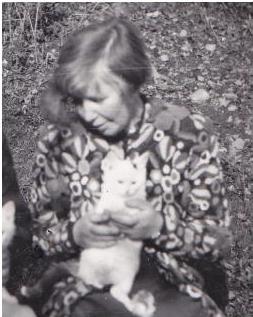Katharine Briggs: Some Thoughts December 12, 2017
Author: Beach Combing | in : Contemporary , trackbackAnyone who studies fairies, witches and the supernatural generally will have a simple series of thoughts about Katharine Briggs (1898-1980): gratitude for keeping the Folklore Society going over a rocky couple of decades; love of her marvelous books, including one of the great fairy novels; and an affection for that brooding severe child of Victorian England who brought science and class, rigour and art, to the study of the impossible in the post-war period. Beach loves Katharine Briggs and everything about her: but over the years adulation has shriveled into affection (a very healthy change). These are just a few scribbled thoughts about the limits of KB’s writing: meditations that have been growing and that sooner or later will burst out into a more serious piece of writing.
Katharine Briggs wrote two scholarly folklore history books: The Anatomy of Puck (1959) and Pale Hecate’s Team (1962). There is then, also, the frustrating but indispensable multi-volume Dictionary of British Folktales. These three works are written to academic standards: something that is also true of many of her articles from the 1950s and 1960s. However, her later works on fairies, including A Dictionary of Fairies and The Fairies in Tradition and Literature are not really university books at all.
Now saying that something is not a ‘university book’ is not necessarily an insult (in fact, often to call a work a ‘university book’ would be an insult: Beach refers the reader to Professor Death). And KMB’s books are civilized reflections on a civilized subject. There is also a refreshing lack of footnotes and absolutely zero pretension. But it is as if by the time these books were written KMB was feeding off her long accumulated knowledge, and was no longer in dialogue with those writing on these subjects.
This might very well be because so very few good writers were dealing with fairies. But it has probably more to do with her own rather peculiar scholarly and imaginative evolution. KMB had immersed herself in the world of faery from the earliest times in a tight family where her most intense relations were with her sisters. She then taught children through the Girl Guides’ movement where she was passionately interest in mime, theatre and story-telling. Then, she began her doctorate in her forties.
The works to come out of her doctorate were first-rate. But once she was left to her own devices, without a supervisor, and with the kudos she had earned from those early works, she fell back on her own resources. The result is that much of her later writing on fairies is her creating an imaginary world and sharing that imaginary world with a wider public. In some cases, she had recycled asides in nineteenth century works, in some cases she seems to have constructed her own private taxonomies.
The result was both good and bad. The good side was that there was now a remarkable series of fairy books with definite information about hazardously amorphous creatures: books that could communicate with the general public as no dry-as-dust work on fairies could do that and one of the pleasures of looking at fairy films and fiction is to see KMB’s massive influence over the popular fairy. The bad side was that her view of fairies, particularly when she left literature behind, is extremely personal and is not always grounded in the sources.
KMB was never a Ruth Tongue. She was always honest in her collecting and her writing. But at some point in her fifties or sixties she decided to mix the role of a scholar with that of a story-teller. Story-tellers are far more valuable than scholars, of course: it was almost certainly the right choice for society at large. But when you read ‘late Briggs’ you must read it with a different attitude. It is not folklore as science: it is folklore as art.
Other thoughts: drbeachcombing AT gmail DOT com
PS A great pleasure in writing this post has been that I found a photograph from the 1940s: the first time I’ve seen the adult KMB.
Southern Man writes, 30 Dec, 2017: ‘Well… Talk about killing your heroes! Just want to share a brilliantly perceptive comment by Jeremy Harte where he notes that Brian Froud’s illustrations are the design form of the KMB dictionary. Through that medium KMB reached millions…’



